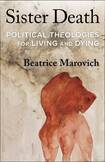Review: Life and death, reconsidered
In Sister Death: Political Theologies for Living and Dying, Beatrice Marovich explores the connections between living and dying in a way that seeks to refute the concept of death as enemy while not accepting it as something that is good or desirable. Rather, she illumines what can be the tragedy of death by linking it to the experience of life and explores the question of human existence from our natality, which brings us into being from nothingness, to a dying that can be perceived as annihilation but also has multiple strands linking it to life.
Using Derrida’s term “lifedeath” to demonstrate a continuity of life and death, Marovich examines the enmity between life and death in Western thought, particularly attending to St. Paul’s reference to death as “the last enemy.” While maintaining nuance and an honest admission that there is more than Paul’s statement in 1 Corinthians behind Christian teaching on the subject, Marovich describes Christianity’s approach to death as reinforcing this enmity.
She discusses the church councils, particularly Chalcedon (451), which defined Christ as divine and human. Marovich argues that Christ’s humanity differs from other humans. He is not a creature in the same sense: Christ, in the resurrection, creates a group of those who are victorious over death and associated with the divine. Over time, in the history of the church, this separation has created a group who are saved, while all others are associated with sin and death. Those associated with sin and death are initially the Jewish people, but the concept eventually was extended to all others who were not Christian, and thus led to violence against Indigenous peoples, the equation of Blackness with death, systems of slavery, and a variety of other systemic inequities that continue to shape how we view one another and our relationship to death.
Using Derrida’s term “lifedeath” to demonstrate a continuity of life and death, Marovich examines the enmity between life and death in Western thought.
In place of this concept of death, Marovich suggests the metaphor of feminist sisterhood, where there is distinction and difference, but also deep relationship and identification in considering death. She borrows the image of Sister Death from St. Francis of Assisi but adapts it to bypass the notion of enmity between death and life.
This book is technical and takes the reader into deep analysis of elements of continental European philosophy. Marovich also makes ample use of feminist, Black and queer theory and theology, which may make the book more suitable for the scholar than the general reader.
Lest that sound too daunting, there is a beauty and kind spirit in Marovich’s writing that kept me engaged even when I found myself a bit overwhelmed by concepts that I had not previously considered or were challenging for me. Marovich is also to be commended because in the exposition of her thesis, she remains nuanced and inviting, realizing that there are other perspectives. Indeed, I found myself wishing I could be in conversation with the author, sometimes debating, sometimes asking for more explanation, and at other times questioning (gently, I hope) whether her interpretation of Christian theology is accurate.
A remarkable feature of this volume, one that enhances the reader’s engagement with a difficult text, are the drawings throughout the text by Krista Dragomer. Dragomer, a friend of Marovich’s and collaborator in workshops, illuminates the author’s points with her work. As Marovich writes:
I wrote this book because I believe that there are real problems—failures—in the language that many of us have been given to make sense of this wild nexus where life and death collide. What I seek to do, in this book, is to gesture toward other possible stories to tell, another sort of language to share, another form of perception. Krista’s images model other forms of perception that are different, still, from the language that I offer as text on the page. In this sense, I hope, her work will illuminate yet other possible stories.
As someone who in the past practiced as a physician in internal medicine and geriatrics and found myself caring for persons in “this wild nexus where life and death collide,” I wish I could have learned more about how the image of Sister Death would illuminate and, perhaps, transform how we care for persons who are facing death. As a priest who has anointed the sick, prayed at wake services, presided at funerals and buried the dead, I wonder how Marovich would suggest our rituals might illuminate or provide a counter-position to her viewpoints.
In short, I am not sure how Sister Death, as presented in this book, makes a difference in how we live and die. But I would love to hear more from Marovich on that topic.
This article also appeared in print, under the headline “From Death Into Life,” in the June 2023, issue.











